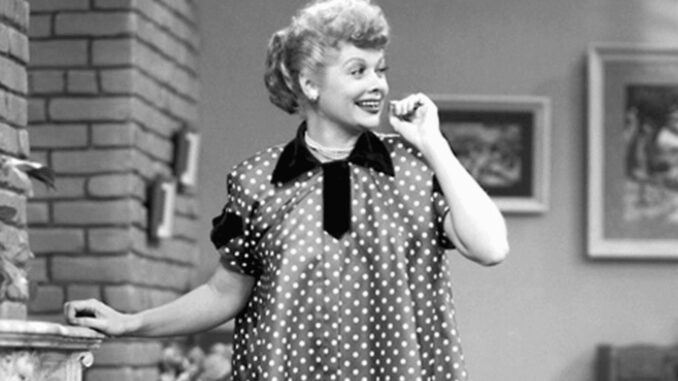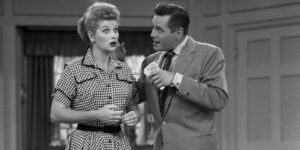
Introduction: How Pregnancy Reshaped Primetime Comedy
When we think of I Love Lucy, we remember the hilarious antics of Lucy Ricardo, brilliantly portrayed by Lucille Ball. But did you know her real-life pregnancy almost derailed the show? Instead of sidelining one of TV’s biggest stars, the creators came up with clever solutions, changing the course of television history. Let’s dive into how this groundbreaking series navigated Lucille Ball’s pregnancy while keeping millions of viewers entertained.
The 1950s Taboo: Pregnancy on TV
Why Pregnancy Was a Controversial Topic
In the conservative 1950s, the mere mention of pregnancy was considered inappropriate for television. Many networks avoided storylines involving expectant mothers, fearing backlash from advertisers and audiences. Pregnancy was viewed as something private, not meant for public consumption.
CBS’s Reluctance to Address Lucille Ball’s Condition
Lucille Ball’s pregnancy was a delicate matter for CBS. Initially, the network balked at the idea of addressing it on-air. Executives worried it could tarnish the family-friendly image of I Love Lucy. However, Ball and her husband, Desi Arnaz, had other ideas.

Lucille Ball’s Groundbreaking Proposal
How Ball and Arnaz Pitched the Idea
Lucille Ball and Desi Arnaz, who played her on-screen husband Ricky Ricardo, proposed incorporating her pregnancy into the show’s storyline. They argued it would not only add authenticity but also resonate with viewers. After much debate, CBS reluctantly agreed—under one condition.
The ‘Expecting’ Rule
The network insisted that the word “pregnant” could not be used. Instead, the show employed euphemisms like “expecting” to keep the storyline palatable for 1950s audiences.
Creative Solutions: Hiding the Baby Bump
Clever Costume Choices
Throughout the early stages of Ball’s pregnancy, the wardrobe department played a crucial role. They used flowing dresses, aprons, and strategically placed props to obscure her growing belly.
Set Design Tricks
Set pieces, like countertops and furniture, were often placed between Ball and the camera. This allowed her to perform without drawing attention to her condition.
The Iconic Pregnancy Episode
“Lucy Is Enceinte” – A Landmark Moment
The episode titled “Lucy Is Enceinte” (French for “pregnant”) aired on December 8, 1952. It was a monumental event, as it marked the first time a major TV show addressed pregnancy. This episode not only captivated audiences but also broke significant cultural barriers.
Viewer Reactions
Fans were thrilled to see the Ricardos preparing for a baby, and the storyline was met with widespread acclaim. The episode drew record-breaking ratings, proving that audiences were ready for more realistic portrayals of family life.

Behind-the-Scenes Challenges
Filming While Pregnant
Ball continued filming into the later stages of her pregnancy, which wasn’t without its challenges. The production schedule had to be carefully planned around her health and comfort.
The Live Studio Audience
With a live audience present during tapings, the cast and crew had to ensure that no slip-ups revealed more than intended. Every scene was meticulously rehearsed to maintain the illusion.
The Birth Episode: A Cultural Phenomenon
“Lucy Goes to the Hospital” Breaks Records
The episode where Lucy gives birth aired on January 19, 1953, coinciding with Ball’s real-life delivery. It became one of the most-watched TV episodes of its time, drawing over 44 million viewers—a staggering number for the era.
Parallel to Real Life
The seamless blending of fiction and reality captivated audiences, making the birth of Little Ricky a historic TV moment.
Legacy of Lucille Ball’s Pregnancy on TV
Breaking Barriers for Future Shows
By addressing pregnancy, I Love Lucy paved the way for more honest storytelling. Shows like The Dick Van Dyke Show and The Brady Bunch followed suit, normalizing pregnancy and other family dynamics on television.
Changing Perceptions of Women in Media
Lucille Ball’s decision to embrace her pregnancy on screen challenged societal norms. She proved that women could be both mothers and successful professionals, inspiring countless viewers.
The Enduring Influence of ‘I Love Lucy’
Setting New Standards in Comedy
The series’ innovative approach to storytelling and character development set a benchmark for future sitcoms. It demonstrated that comedy could tackle serious life events without losing its charm.
Lucille Ball’s Role as a Trailblazer
Ball’s fearless approach to television redefined the industry. Her legacy as a pioneer continues to influence creators and performers today.
Conclusion: A Bold Move That Paid Off
Lucille Ball’s pregnancy could have been a hurdle for I Love Lucy, but instead, it became one of its greatest strengths. By skillfully incorporating real-life events into the storyline, the show not only entertained but also broke cultural barriers. It’s a testament to the power of authenticity and the importance of taking risks in storytelling.
FAQs
1. Why couldn’t CBS use the word “pregnant” on I Love Lucy?
The term was considered too risqué for 1950s television, so the network opted for more acceptable alternatives like “expecting.”
2. How did audiences react to Lucy’s pregnancy storyline?
Viewers loved it! The episodes featuring Lucy’s pregnancy garnered record-breaking ratings and widespread acclaim.
3. Was Lucille Ball the first pregnant woman on TV?
Yes, Ball was the first actress to portray a pregnant character on a major TV show, making television history.
4. Did Lucille Ball and Desi Arnaz’s real-life relationship influence the show?
Absolutely! Their real-life dynamics often inspired storylines, adding a layer of authenticity to the show.
5. What impact did I Love Lucy have on future TV shows?
It broke barriers, paving the way for more realistic portrayals of family life and opening doors for women in television.
